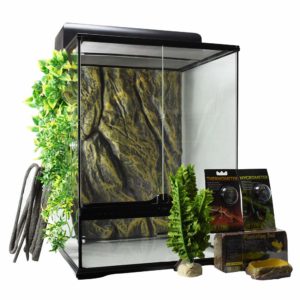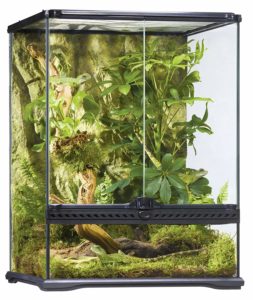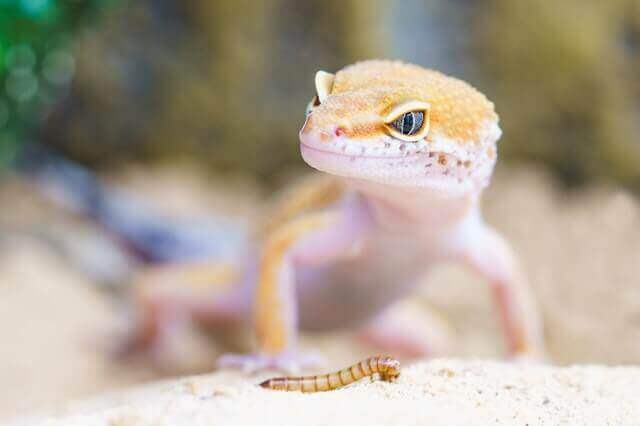Domesticating a reptile might sound bizarre to some people initially, but leopard geckos are among the first reptiles to be domesticated. They are the reptilian version of goldfish and parakeet. Owners are very concerned with leopard gecko Vivarium habitat setup.
| Product Name | Product Preview | Check Price |
|---|---|---|
| Rainforest Habitat Kit (includes PT2607) |  |
Check Price |
Leopard geckos are among the first lizards which were considered so attractive that they soon a popular pet. Apart from their attractive skin, these lizards are easy to care for, long-lived with a perfect size and a potentially robust breeder.
An average leopard gecko fledging is about 6cm long and they grow up to the size of 20-25cm. A leopard gecko with a fat tail is considered healthy and you should avoid buying one with a thin tail.
They have a lifespan of about 8 years. Unlike the conventional lizard, leopard geckos lack adhesive toe pads. Leopard geckos are originally found in the humid and harsh areas of Pakistan, Afghanistan, Iran, and India.
When it comes to petting these lizards, housing plays a pivotal role in the growth and well being of your leopard gecko. There are certain products available in the market for housing your Leo commonly known as leopard gecko vivarium.
Choosing an ideal vivarium for your gecko might sound easy but certain aspects shall be taken into consideration while doing so.
-
Leopard gecko vivarium size –
A solid leopard gecko Vivarium habitat with a capacity of around 10 gallons is an ideal sized tank for your gecko. Roughly, with every Leo you add, an additional of 5 gallons is required in order to ensure the healthy growth of the reptile. Leopard geckos prefer vivarium which are longer rather than the shallow ones because they stay on the ground and do not require tall and narrow tanks like chameleons.
-
Leopard Gecko Vivarium material
– Majorly, there are three types of vivarium available in the market for your leopard gecko. These vivariums are defined as Glass, plastic and wooden vivarium.
-
Glass vivarium
Product Name Product Preview Check Price EXO Terra Glass Terrarium 
Check Price – Glass tanks are a classic option for providing housing to your leopard gecko. These have the highest visibility and are easy to disinfect as they are easy to clean. The issue with glass vivarium is that they are not durable and are brittle. This vivarium cannot be altered with any new fitting and holes.
-
Plastic vivarium-
These leopard gecko vivariums are made out of PVC or ABS plastic which is very popular among the customer because of their durability and adaptability. These tanks are comparatively lighter and easy to manage. They can be altered with drilling and other adjustments. Plastic tanks are relatively cheaper when compared to glass ones. The cons of this tank are that it is hard to maintain because they are more prone to scratching.
-
Wooden vivarium-
Wooden leopard gecko vivarium is the cheapest among all of these as it is enclosed by wooden sheets from three sides. These tanks are easily available but they lack hygiene as wood is porous which leads to water absorption. This makes it a really tough task to disinfect until you use the waterproof coating.
Leopard gecko vivarium ventilation and access –
Ventilation plays an important role in managing the reptiles as the adequate passage of air is required in the vivarium.
There are two major types of ventilation commonly known as active and passive ventilation or a combination of both, Passive ventilation is achieved through covering the lid or a part of it while active ventilation is done through electronic ventilators.
Tank access is the passage to access the tank which is of two types- from the upside of the vivarium and the downside of the vivarium.
Downside access is discouraged as there are greater chances of the reptile to escape in that, Upside access is a natural condition which helps them imitate their natural habitat.
-
Humidity and water for leopard gecko Vivarium-
since leopard geckos are originally from Asia, they require hot and humid climate which shall be replicated in the vivarium in order to ensure the best of their health. Failing to do so would lead to complications with the Leo shedding its skin, preparing its burrow and reproducing. Without the ample amount of humidity, the reptile would not be able to reproduce in a robust manner and the shedding of skin would not take place consistently.
-
The temperature for leopard gecko vivarium-
Reptiles are well known for their exothermal tendencies which means that their body temperature depends on the outer stimulation. Leopard gecko requires two different intensity of temperature in the vivarium to maintain their body temperature (75 to 85 degrees Fahrenheit).
-
Lightning for leopard gecko vivarium-
Leopard geckos are nocturnal reptiles, so adequate lightning cycles have to be maintained. Suitable lighting devices are also available for leopard gecko vivarium to propagate healthy lifestyle and behavior of your
Considering the sensitivity of these reptiles and the care which is to be maintained while petting these reptiles, these aspects are to be thoroughly taken care of in order to maintain healthy wellbeing of your leopard gecko.
